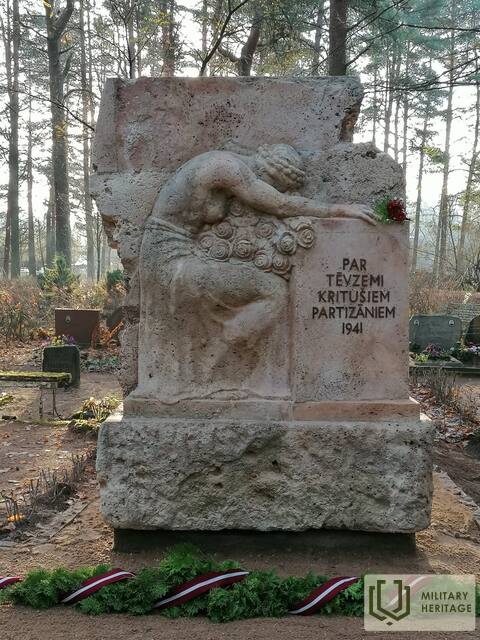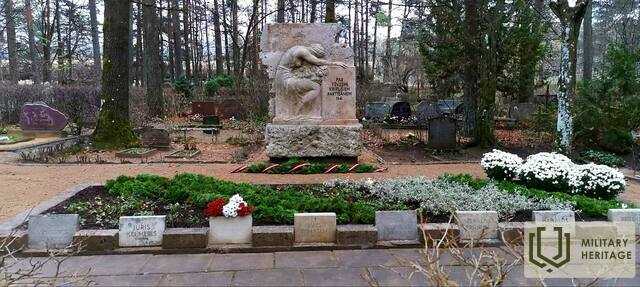Monument "Grieving mother" at Inčukalns Cemetery of Honour
Memorial site

 50
50



Located: Inčukalns municipality, Inčukalns, Miera Street, Inčukalns cemetery.
Monument opened: July 16, 1944. Monument opened after the death of K. Zāle. Inscription: For the fallen partisans of the Fatherland in 1941 (restored). Monument restored on November 5, 2020. Monument restored with the support of the Inčukalns Regional Council. Restorer artist Igors Dobičins.
Events: “On June 17, 1940, Latvia was occupied by the USSR. On June 14, 1941, deportations were carried out. On June 22, 1941, Germany attacked the USSR and units of the Wehrmacht entered Latvia. The Red Army and its supporters retreated. In many places in Latvia – including Ragana, Sēja and Inčukalns – former guards and patriotic young people organized themselves to protect their homes and rush to drive out the Soviet occupiers. When the flag of the Free State of Latvia was raised again in the “Ziediņi” (Flowers) neighborhood of Sēja parish on July 1, 1941, special units of the Red Army shot the landlady of this house – 39-year-old Elza Viša – at the Northern Cemetery, and her mother – 64-year-old Elza Martinova – at the border of Sēja and Krimulda parishes. This created even more hatred and indignation among the residents of the area, and they began to gather in the people's resistance movement and form self-defense units, which were also called the first partisans (the leader of the Inčukalns group was Maksis Cālītis). The fighters of the region were also joined by soldiers and officers from the so-called Latvian Territorial Corps who had escaped from the Litene military camp or who had been released. An armed clash with the Reds took place a few days later, on July 4, and seven soldiers and the son of the pharmacist from Ragana, Pēteris Prašķēvičs, died in the battle. In addition, the 17-year-old student of the Rēzekne Teachers' Institute, Jānis Porietis, was also wounded and taken prisoner in the Battle of Ragana, who was tortured, shot and buried near Straupe.
Here in Inčukalns, a common grave of brothers was dug out, to which coffins made of white unplaned boards were brought one by one in eight horse-drawn carriages, so that the fallen heroes could be laid to rest in their native land. A few months later, already during the German occupation, a monument designed by Kārlis Zāles (from 1939 until the end of his life on February 19, 1942, due to a serious illness, the brilliant Latvian sculptor chose Inčukalns as his place of residence) was installed in the cemetery - the image of a grieving mother over a rose lap. In the 1950s, local communist activists blew up the monument. The monument lay damaged and motionless until the Awakening, when in the late 1980s more and more people became interested and talked about the events of July 4, 1941 and called for the restoration of the Kārlis Zāles monument. This demand was voiced on September 8, 1988, at a meeting of the people and authorities convened at the Inčukalns Elementary School, which was attended not only by the residents of Inčukalns, but also by residents of nearby parishes, as well as members of the Environmental Protection Club and the Latvian National Union of Communists from Riga.
… The residents of Inčukalns actively participated in the restoration of the monument – Teodors Ildens, Arvīds Blaus, Pēteris Vorfolomējevs, … and many other patriotic people. On July 4, 1989, the newly reborn noble and sad monument was consecrated by the priest Vaira Bitēna in a solemn ceremony.”
Used sources and references:
https://latvijaspieminekli.lv/incukalns-1941-gada-4-julija-raganas-kauja-krituso-astonu-nacionalo-partizanu-pieminai/
Related timeline
Related stories
Karlis Hall and Freedom Monument
The narrator describes the memories of Kārlis Zāles as a personality who created the most famous works of Latvian art. The description is dedicated to the memory of Zāles in 1942 (the year of K. Zāles' death). The memories were chosen to characterize K. Zāles' works based on the author's personal characteristics and perception of the world.






